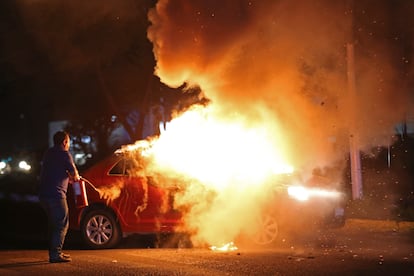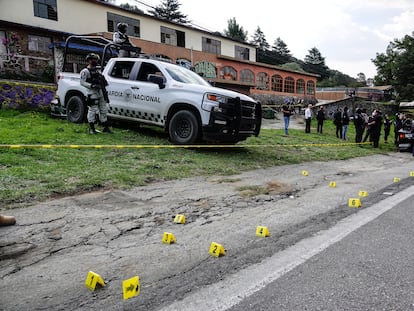Night of terror in Mexico raises alarm bells in US over narco violence
Washington issued a security alert on Wednesday after the Jalisco New Generation Cartel stormed two states, blocking roads and burning vehicles

“Seek secure shelter.” That was the recommendation for staff of the United States consulate in Guadalajara after the Mexican city descended into violence, with local authorities reporting multiple road blockades, burning vehicles and shootouts. The security alert was issued late on Tuesday in response to the night of terror that followed the attempted capture of a regional leader of the Jalisco New Generation Cartel (CJNG). The drug cartel fought back against the Mexican army in the states of Jalisco and Guanajuato, blocking roads and setting fires to cars.
Five were arrested, and one alleged gang member died in the clashes, according to figures provided by the governor of Jalisco, Enrique Alfaro, on Wednesday. Mexican President Andrés Manuel López Obrador said the narco violence was in response to an army operation in the middle of a conclave of two criminal gangs. Security forces were deployed for several hours until they were able to reestablish control. By noon, the US Consulate had withdrawn the security alert, although it said it “continued to closely monitor the situation.”
Mexico, the top tourist destination for Americans in 2021, continues to raise alarm bells in Washington. The White House has issued travel warnings for 30 of the 32 states of Mexico. The Joe Biden government has asked US citizens to reconsider travel to Jalisco and Guanajuato. “In Guadalajara [the capital of Jalisco], territorial battles between criminal groups take place in tourist areas. Shooting incidents between criminal groups have injured or killed innocent bystanders,” reads the travel advisory.
In the case of the state of Colima, the US recommends against travel to the state due to the “widespread” violence. Five months ago, the state was under siege by the CJNG after two of its commanders were arrested. The CJGN is listed as one of the five most dangerous cartels in Mexico.
The US also recommends against travel to the states of Guerrero, Sinaloa, Michoacán and Tamaulipas. “Violent crime – such as homicide, kidnapping, carjacking and robbery – is widespread and common in Mexico,” the consulate warns.
But Ken Salazar, the US ambassador to Mexico, has spoken more optimistically about the situation in Mexico. Just hours before the violence broke out in Guadalajara, he met with the governor of Colima, Indira Vizcaíno, and offered to help tackle the security crisis. At the meeting in Colima – another drug cartel hot spot – he said he was optimistic about the situation, citing progress in the binational fight against crime. He also called for more criminals to be extradited to the US, arguing this was an effective measure to curb crime. “We want them in the United States, send them to us as soon as possible,” he said, as reported by the Mexican magazine Proceso. One of the most high-profile figures set to be extradited is drug trafficker Rafael Caro Quintero, who was arrested a few weeks ago for the murder of DEA agent Enrique “Kiki” Camarena in the 1980s.
The June 20 murder of two Jesuit priests and a tourist guide in the northern state of Chihuahua also raised alarm in Washington. In response to the spiraling violence, a group of 24 Democratic congressmen sent a letter to Biden last week in which they expressed concern over the “senseless bloodshed” in Mexico and urged the government to collaborate with the López Obrador administration to punish those responsible. The suspects arrested for the murders belong to Los Salazar, a cell of the Sinaloa cartel.
Two weeks before the murdered Jesuits, the US Congress released a report that indicated that the most significant event in Mexico’s criminal ecosystem has been the emergence of the CJNG and its battle with the Sinaloa cartel, which was formally led by Joaquín “El Chapo” Guzmán. The CJNG, which traffics synthetic drugs, has its strongholds in western Mexico, according to the report. The Jalisco cartel is fighting against the Zetas for control over the Gulf of Mexico region; and is taking on local groups in Michoacán, the State of Mexico and Oaxaca. In the state of Quintana Roo, a popular tourist destination, the CJNG is in a turf dispute with the Sinaloa cartel. The report criticized the Mexican government’s “hugs, not bullets” policy and said that cooperation with US agencies on security issues had declined under the López Obrador administration.
López Obrador’s visit to Washington in mid-July appeared to have improved bilateral collaboration, leading to the capture of cartel leaders such as Caro Quintero and two operations against the Sinaloa cartel in central Mexico, including the largest seizure of cocaine in history. Analyst Andrew Selee, however, does not believe that the recent violence will increase pressure on the Mexican government, but he does think that both sides of the border are interested in achieving greater understanding and resuming intelligence sharing. “This makes it possible to hit some of the criminal networks that are of most concern,” says Selee, who is the president of the Migration Policy Institute.
Meanwhile, the DEA is keeping its sights on Mexican drug lords. Its top targets are Nemesio “El Mencho” Oseguera from the CJNG and Ismael “El Mayo” Zambada, the assumed leader of the Sinaloa cartel. But arresting drug leaders is a challenge. In this latest attempt to arrest a local leader of the Jalisco cartel, roads were blocked, dozens of vehicles were stolen and 25 Oxxo convenience stores were set on fire, in Guanajuato alone, according to the chain.
Tu suscripción se está usando en otro dispositivo
¿Quieres añadir otro usuario a tu suscripción?
Si continúas leyendo en este dispositivo, no se podrá leer en el otro.
FlechaTu suscripción se está usando en otro dispositivo y solo puedes acceder a EL PAÍS desde un dispositivo a la vez.
Si quieres compartir tu cuenta, cambia tu suscripción a la modalidad Premium, así podrás añadir otro usuario. Cada uno accederá con su propia cuenta de email, lo que os permitirá personalizar vuestra experiencia en EL PAÍS.
¿Tienes una suscripción de empresa? Accede aquí para contratar más cuentas.
En el caso de no saber quién está usando tu cuenta, te recomendamos cambiar tu contraseña aquí.
Si decides continuar compartiendo tu cuenta, este mensaje se mostrará en tu dispositivo y en el de la otra persona que está usando tu cuenta de forma indefinida, afectando a tu experiencia de lectura. Puedes consultar aquí los términos y condiciones de la suscripción digital.
More information
Últimas noticias
Trump claims peace in Ukraine is near, but Moscow suggests otherwise
A survivor’s account of the Interoceanic Train accident: ‘We were scared because of the speed on the curve’
The Interoceanic Train, the Mexican alternative to the Panama Canal
What is known about the Interoceanic Train derailment in Oaxaca
Most viewed
- Oona Chaplin: ‘I told James Cameron that I was living in a treehouse and starting a permaculture project with a friend’
- Reinhard Genzel, Nobel laureate in physics: ‘One-minute videos will never give you the truth’
- Why the price of coffee has skyrocketed: from Brazilian plantations to specialty coffee houses
- Pablo Escobar’s hippos: A serious environmental problem, 40 years on
- Chevy Chase, the beloved comedian who was a monster off camera: ‘Not everyone hated him, just the people who’ve worked with him’











































